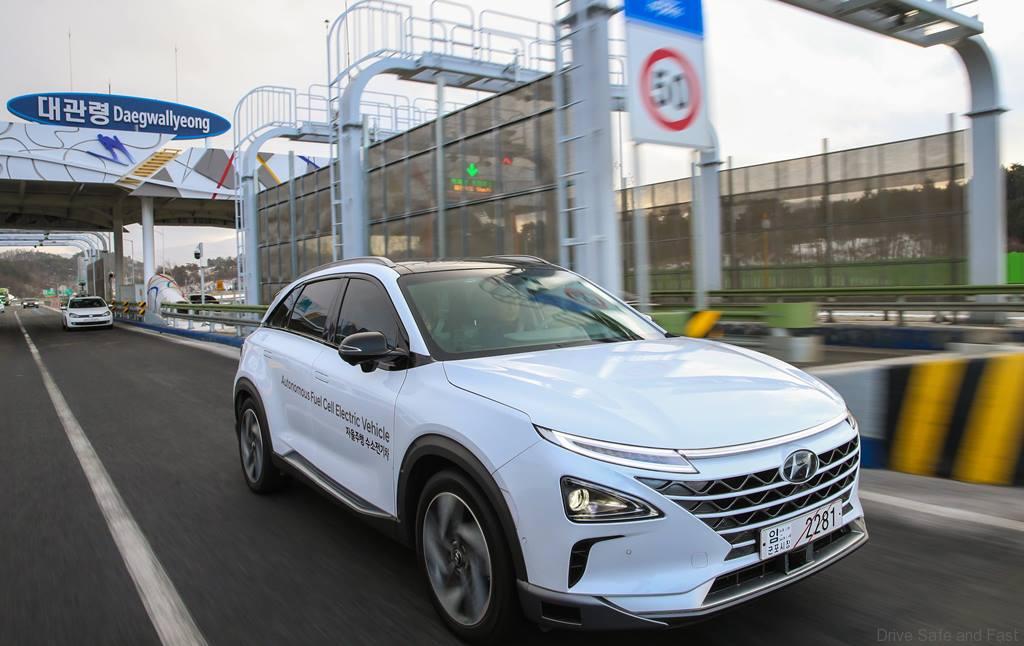A fleet of Hyundai Motor Company’s next-generation fuel cell electric cars have succeeded in completing a self-driven 190 kilometres journey from Seoul to Pyeongchang. This is the first time in the world that level 4 autonomous driving has been achieved with fuel cell electric cars, the ultimate eco-friendly vehicles.
Until now, autonomous driving has been demonstrated at a limited speed on some sections of domestic roads, but this is the first time autonomous cars have driven such a long distance at 100 km/h-110 km/h, the maximum speed allowed by law on Korean highways.
Five Hyundai vehicles completed the journey. Three vehicles are based on Hyundai’s next-generation fuel cell electric SUV NEXO, scheduled to be released in Korea next month, and [the other two are Genesis G80 autonomous vehicles. All vehicles are equipped with level 4 self-driving technology, as defined by the SAE international standards, and 5G network technology. The vehicles used for the demonstration are “futuristic vehicles” that closely represent Hyundai’s three visions for future mobility: connected mobility; freedom in mobility; and clean mobility.
The demonstration started in Seoul on Feb. 2 with the ‘CRUISE’ and ‘SET’ buttons being pressed on the autonomous-driving steering wheel of each vehicle, at which point the cars immediately switched to the self-driving mode and began the 190 km journey to Pyeongchang. Entering the highway, the vehicles moved in response to the natural flow of traffic. They executed lane changes and overtaking manoeuvres, and navigated toll gates using Hi-pass, South-Korea’s wireless expressway payment system.
Building on the successful demonstration of Hyundai’s vehicles which drove autonomously in Las Vegas during the Consumer Electronics Show (CES) early last year, these cars featured a number of advanced technologies that enabled them to recognize surrounding vehicles more accurately and make better judgements at junctions and at branching roads, navigate through toll gates by accurately calculating the toll gate’s width and position, and precisely pinpoint the vehicle’s position on a map by using external sensors fitted for situations when the GPS signal was interrupted, such as going through long underground tunnels.
Hyundai conducted a significant number of highway test drives amounting to hundreds of thousands of kilometres travelled, which enabled them to accumulate a vast amount of data that helped enhance the performance of its self-driving vehicles.
The exterior and interior of self-driving vehicles used for this demonstration look similar to Hyundai’s other mass-produced models, but they are installed with various cameras and LIDARs. Adding a small number of sensors to mass-produced vehicles has enabled the realization of fully autonomous driving technology, and thus brings the company a step closer to the commercialization of self-driving technology.
Autonomous driving processes a high volume of data, which requires a lot of power. The fuel cell electric model is able to produce electricity through a reaction between hydrogen and oxygen in the fuel cell stack, making it the optimal vehicle model choice for this test.
The NEXO fuel cell electric SUV can drive more than 600 km on a single charge, which takes approximately five minutes to refuel. The model boasts world-class system efficiency of 60%, durability equivalent to internal combustion engine-driven vehicles and a load space of 839 litres.





